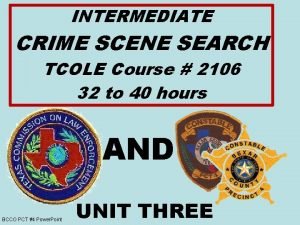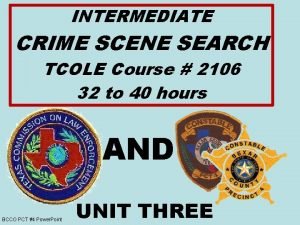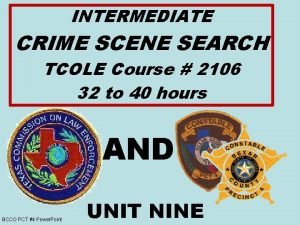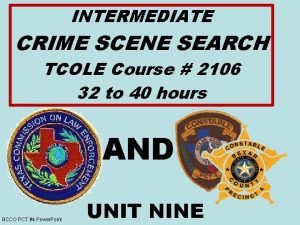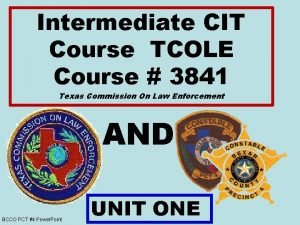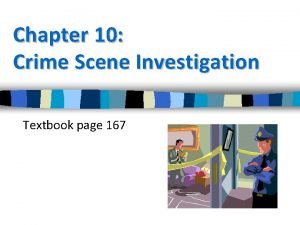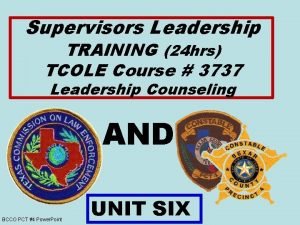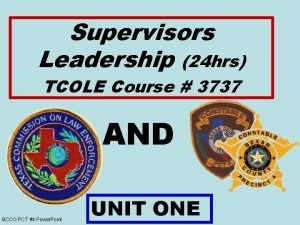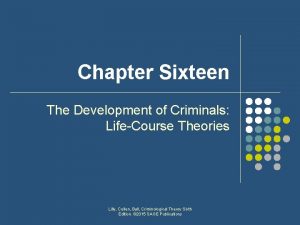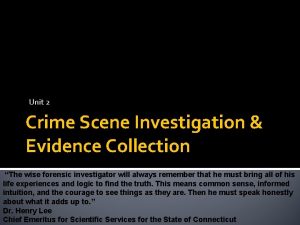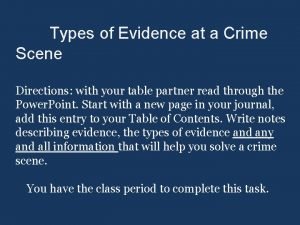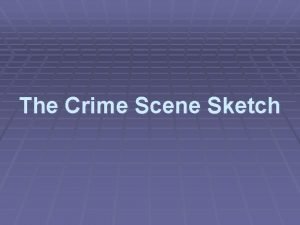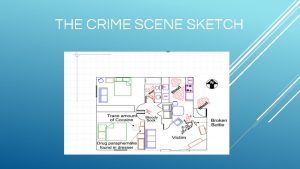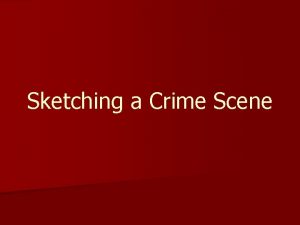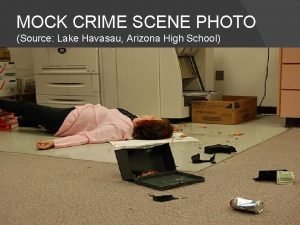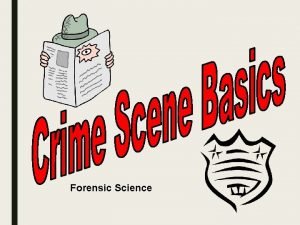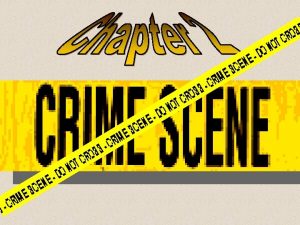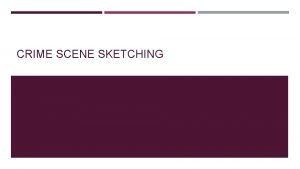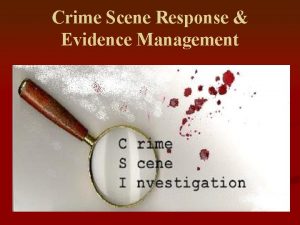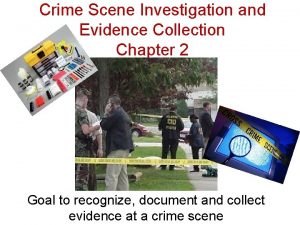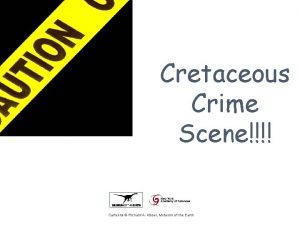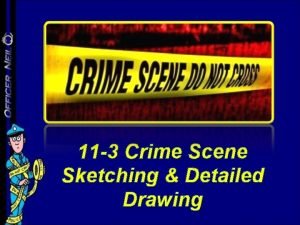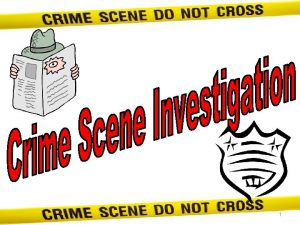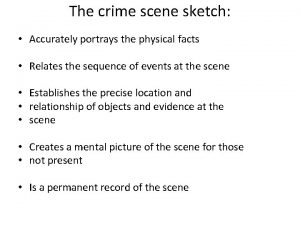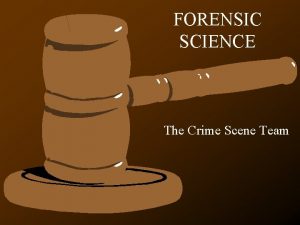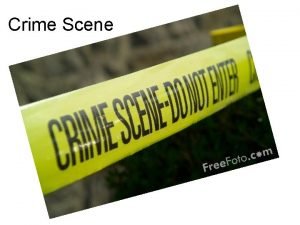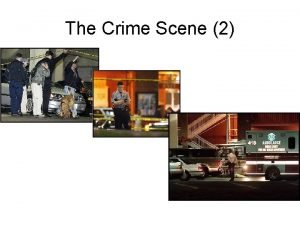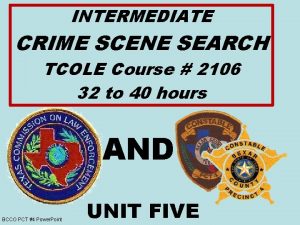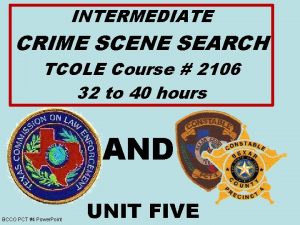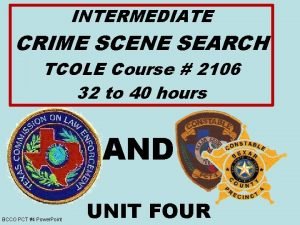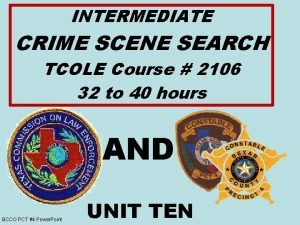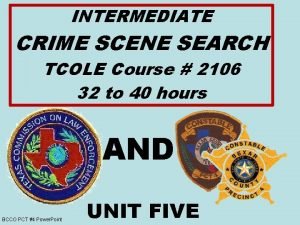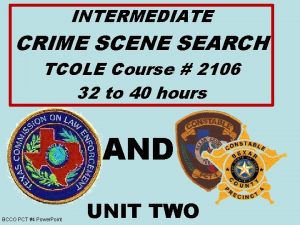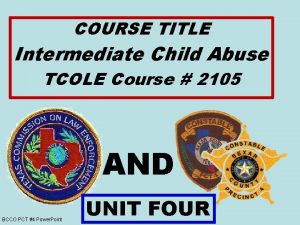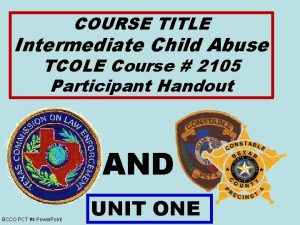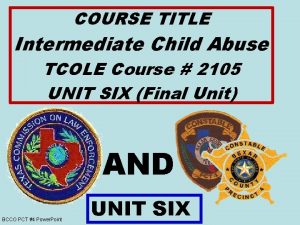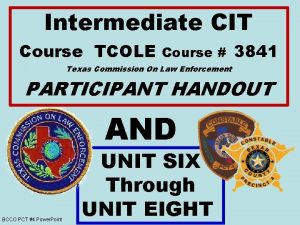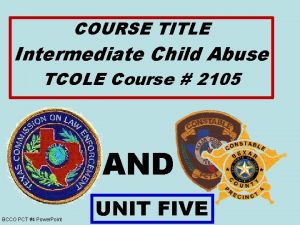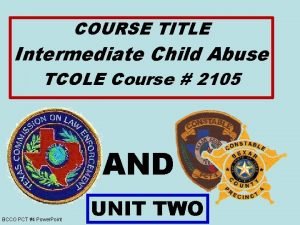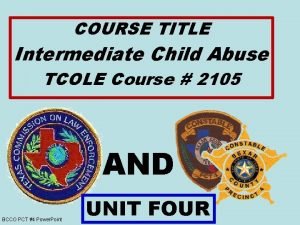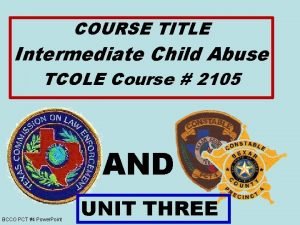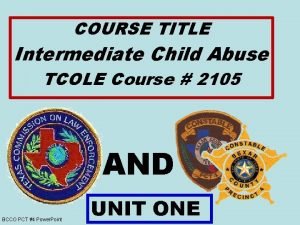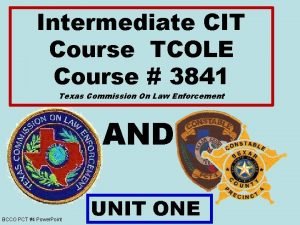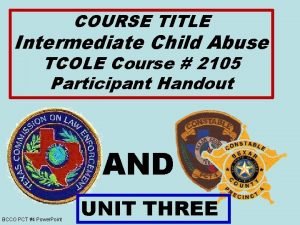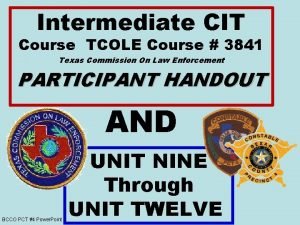INTERMEDIATE CRIME SCENE SEARCH TCOLE Course 2106 32
















































- Slides: 48

INTERMEDIATE CRIME SCENE SEARCH TCOLE Course # 2106 32 to 40 hours AND BCCO PCT #4 Power. Point UNIT THREE

Learning Objectives Learning Objective 3. 1 The student will be able to summarize major issues of crime scene investigation. Learning Objective 3. 1. 1 The student will be able to list a basic guideline for conducting a crime scene search. Learning Objective 3. 1. 2 The student will be able to identify the methods of conducting a preliminary investigation. Learning Objective 3. 1. 3 The student will be able to explain the importance for establishing a “chain of custody. ” Learning Objective 3. 1. 4 The student will be able to explain the importance for conducting a final survey of the crime scene. Learning Objective 3. 1. 5 The student will be able to explain the importance for debriefing the search team. Learning Objective 3. 1. 6 The student will be able to explain the importance for maintaining a case file. Learning Objective 3. 1. 7 The student will be able to explain the importance for conducting a follow-up investigation

3. 0 Investigating a Crime Scene

3. 1 Major Crime Scene Investigation Issues

3. 1. 1 Guidelines for Conducting Crime Scene Search A. The basic steps of which a crime scene search normally progresses are as follows: 1. Approach _____. 2. ______ and _______. 3. Preliminary ______.

Continued: 3. 1. 1 4. ____ the possibilities of physical evidence. 5. Establish a “_____ of _______. ” 6. Narrative _______. 7. _____ scene. 8. ______ scene. 9. Fingerprints/Latent prints. 10. Identify, _______, and preserve ____.

11. Evaluation of ___ evidence. 3. 1. 1 12. Detailed ______. 13. Evaluation of actual ________. 14. Collection, recording, marking and _____ of _____. 15. Final survey to ensure conditions of the crime scene have been ______ as thoroughly as possible.

Continued: 3. 1. 1 16. Release scene after to ensure that all ____ is appropriately collected, marked for identification, and properly documented. 17. Debriefing. 18. Notify next of ____. 19. Transport ____, body, etc. 20. Create ____ file.

Continued: 21. ____ results, autopsy, etc. 22. Press _______ or _____ conference. 23. Follow-up _______. Note: Refer to department policy/protocol for particular order of steps 3. 1. 1

3. 1. 2 Preliminary Investigation Methods A. Basic steps of a preliminary investigation. 1. Upon arrival at the scene, _____ if a ______ has been committed. (The specific crime and elements of the offense. )

Continued: 2. Cautiously approach and enter the 3. 1. 2 _____, perform a “_______, ” remaining observant of any person, vehicles, events, potential evidence, and environmental conditions. 3. Provide _____ to injured persons and request emergency medical attention, if necessary. 4. Determine if a _______ is involved and secure it.

5. Locate and interview victims and 3. 1. 2 witnesses. Keep witnesses _____. Be aware of any persons or vehicles attempting to leave the scene. 6. Obtain identification of ______’ name, date of birth, address, residential telephone number, place of employment, and work phone number and other important information. 7. Document specific information in “_____” _____ regarding the crime scene.

Continued: 3. 1. 2 8. Identify and ______the person responsible, if possible. Determine whether a “_______" would be of value (if the suspect is still in the vicinity). 9. Conduct a “neighborhood or ____-to____ canvass, ” if necessary. 10. Remain _____ and _____. 11. Follow agency policy.

3. 1. 2 (B. ) Field Notes 1. Good report-writing skills and style are necessary. 2. Develop a note taking system, such as using initials instead of complete names. However, do not make it difficult for others to interpret your notes.

Continued: 3. 1. 2 (B. ) 3. Use spiral notebooks, interview field (IF) cards, tape records, or other. 4. Obtain and record the follo 9 wing information: a. ____ d. _______ b. ____ e. ____ c. _____ f. ___

3. 1. 2 (B. ) • • WHO observed the crime? Saw the suspects? Committed the crime? Had a ______ for committing the crime? • Accompanied the suspect? • Called the police? • Is/was the victim?

3. 1. 2 (B. ) WHAT • ______ was committed? • Was stolen, damaged, or otherwise affected? • ____ has been located? • _____ were made? • Additional information is needed?

3. 1. 2 (B. ) • • • WHEN Was the crime ____? Did the crime occur? (____) Were the police notified? When did you arrive on scene? Was any ____ located? ______ are essential to your case.

3. 1. 2 (B. ) WHERE • Did the crime occur? (____) • Was the ____ located? • Do the suspects _____? • Do the witnesses live? • Was _____ on victim found?

3. 1. 2 (B. ) WHY • Was the crime committed? • Was that victim chosen? • Was that location chosen? • Was that specific property taken?

3. 1. 2 (B. ) HOW • Did the suspects get in? • Was the crime committed? • Was evidence discovered? • Was victim found? (In what physical and/or mental condition)

3. 1. 2 (C. ) Crime Scene Protection 1. Protect the crime scene from ______, contamination, or removal of ____ and loss of property. 2. If necessary, use street barricades, ropes, “____" tape, or additional personnel around the perimeter to keep unauthorized persons out.

3. 1. 2 (D. ) Potential Evidence 1. Once evidence has been located, remind personnel not to _____, or ______ the items, in any way, until the evidence has been: a. ______. b. ____. c. _____. d. Ready to be ____, ______, and _____

3. 1. 3 Chain of Custody A. A ______ of all individuals who handle the evidence, as well as any details of events. B. ______ should begin during the preliminary investigation. C. Ensure that _____ tags are created

Continued: 3. 1. 3 D. Each time the ____ exchanges possession from one person to another, or moves from one location to another, the investigator must record this transaction. E. It is critical to ______ all pertinent information possible and maintain the chain of custody. F. Always follow department _____ & _____ and protocol

3. 1. 4 Final Survey of the Crime Scene A. Consists of a final “_______” of the crime scene. B. Ensures that ____ has been collected and scene has been processed prior to release. _______

Continued: 3. 1. 4 C. Ensures that ____, equipment, or materials are not inadvertently left behind and dangerous materials or conditions have been reported and addressed. D. During the ________, the following should be ensured: 1. Each ___ identified as part of the crime scene is visually _____

3. 1. 4 D. 2. All evidence _____ at the scene is _____ for. D. 3. All _____ and materials generated by the investigation are _______. D. 4. Any _____ materials or conditions are reported and addressed. D. 5. Crime scene is ____ in accordance to department policy

3. 1. 5 Debriefing Search Team A. Usually established and conducted by ______ (s) who are in charge of the search. B. Conducted after the final ______ is completed.

Continued: 3. 1. 5 C. Enables law enforcement personnel and other responders to ________ regarding particular _____ findings prior to releasing the scene.

Continued: 3. 1. 5 D. Provides an opportunity for input regarding future follow-up investigation, special requests for assistance, and the establishment and verification of post-scene responsibilities (Body identification, notification, press relations, and evidence transportation).

Continued: 3. 1. 5 E. Determines/identify the need for a specialist (e. g. crime laboratory technicians, social services, entomologists, OSHA). F. Communicate with the _____ about responding to the scene or to schedule an autopsy, if necessary.

Continued: 3. 1. 5 G. Share investigative data (if collaborating with other law enforcement agencies/jurisdictions).

Continued: 3. 1. 5 H. Helps in following ways: 1. Determine what evidence was collected 2. Discuss preliminary scene ____ with team members. 3. Discuss potential technical forensic testing, crime laboratory, storage facility, and the sequence of tests to be performed.

Continued: 3. 1. 5 I. Good opportunity for investigators and other responders to ensure that the crime scene search is ____. J. Allows law enforcement officials to prepare a _______ or public ______ conference, if necessary Remember the “_______” can help you find perpetrators !

Continued: 3. 1. 5 K. Allows the investigator (s) in charge make special requests and to remind all _____ of maintaining confidentiality of case. L. Follow agency policy and protocol. _____

3. 1. 6 Case File A. _______ and other documents are compiled into a case file by the investigator(s) in charge of the search. B. The file is a ______ of all actions taken and evidence collected at the scene

Continued: 3. 1. 6 C. This documentation allows for independent ______ of the work conducted, or if preparing a case for prosecution. D. A case file contains the following information: 1. Initial _____ (s) documentation. 2. Emergency _______ personnel documentation.

Continued: 3. Entry/exit ______. 3. 1. 6. D. 4. ______/______. 5. Crime scene ____ & ____. 6. ____ documentation/copies of tags.

Continued: 3. 1. 6. D. 7. Other ______ documentation. 8. Record/copy of _______ form or _______ warrant. 9. Forensic _______, as they become available.

NEW Continued: 3. 1. 6. D. 10. Case Reading File. a. Time/date activity log. b. Chronological order from oldest to newest entry. c. Short summary of what you do concerning this case. d. Ready reference tells you what you need to do and by when.

3. 1. 7 Follow-Up Investigation A. Reasons for conducting a follow -up investigation. 1. Conducted to follow-up on leads pertinent to the case once the preliminary investigation has been concluded.

Continued: 3. 1. 7. A 2. Should be based on what is _____ or _______ during the preliminary investigation. 3. Consists of ______-_______ on addresses, possible escape routes, and other _____ that may provide important new information.

Continued: 3. 1. 7 B. Tasks performed in a follow-up investigation include the following: 1. Analyzing _______ and documents to ensure ____. 2. Reviewing official departmental _______and ____ for more evidence. 3. Gathering information on _______ and _____ of suspect (s).

Continued: 3. 1. 7. B 4. Examining the ____ background. 5. Checking police ______ files to develop potential suspect (s). 6. Organizing police _______, such as neighborhood canvassing, raids, and search warrants.

Questions?

SOURCES • DOJ Research Report, Death Investigation: A Guide for the Scene Investigator, November 1999. • DOJ Research Report, Eyewitness Evidence: A Guide for Law Enforcement, October 1999.

THANK YOU STAY SAFE & STAY VILIGANT This Power. Point and all associated lesson materials herein are the property of BCCO PCT#4
 Intermediate crime scene search #2106
Intermediate crime scene search #2106 Intermediate crime scene search #2106
Intermediate crime scene search #2106 2106 crime scene investigation
2106 crime scene investigation Crime scene
Crime scene Tcole 2106
Tcole 2106 Tcole cit training
Tcole cit training Strip search method crime scene
Strip search method crime scene The seven s's of crime scene investigation
The seven s's of crime scene investigation Csi search patterns
Csi search patterns Basic instructor course tcole
Basic instructor course tcole Basic instructor course texas
Basic instructor course texas Basic instructor course texas
Basic instructor course texas Tcole new supervisor course
Tcole new supervisor course Tcole 1014 basic instructor course
Tcole 1014 basic instructor course Tcole 3737
Tcole 3737 Tcole advanced instructor course
Tcole advanced instructor course Tcole advanced instructor course
Tcole advanced instructor course Basic instructor course tcole
Basic instructor course tcole Developmental theories
Developmental theories Life course theory crime
Life course theory crime West memphis 3 autopsy photos
West memphis 3 autopsy photos Seven s's of crime scene investigation
Seven s's of crime scene investigation Types of crime scene
Types of crime scene Dena schlossers case
Dena schlossers case Druggist fold definition
Druggist fold definition Compass point method
Compass point method Rough sketch crime scene
Rough sketch crime scene Graphsketch
Graphsketch Crime scene rough sketch
Crime scene rough sketch Mock crime scene scenarios
Mock crime scene scenarios Crime scene factoring and quadratic functions answer key
Crime scene factoring and quadratic functions answer key Forensic science vocabulary
Forensic science vocabulary Forensic science begins at the crime scene.
Forensic science begins at the crime scene. Final sketch crime scene
Final sketch crime scene Crime scene photography management
Crime scene photography management While the csi team is searching the crime scene, _____.
While the csi team is searching the crime scene, _____. Crime scene vocabulary
Crime scene vocabulary Cretaceous crime scene
Cretaceous crime scene Disadvantages of overhead sketches
Disadvantages of overhead sketches Crime scene investigation vocabulary
Crime scene investigation vocabulary What must be included on a crime scene sketch
What must be included on a crime scene sketch Crime scene storyboard
Crime scene storyboard Robert pickton trailer
Robert pickton trailer Rough sketch vs final sketch crime scene
Rough sketch vs final sketch crime scene Crime scene reconstruction definition
Crime scene reconstruction definition _____ is done with the first responding officer.
_____ is done with the first responding officer. Crime scene investigation background
Crime scene investigation background Sketch preparer
Sketch preparer Crime scene inference
Crime scene inference
